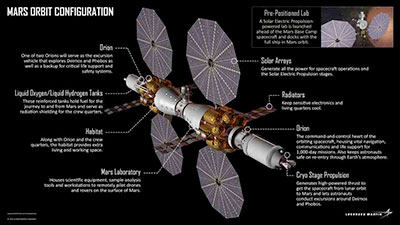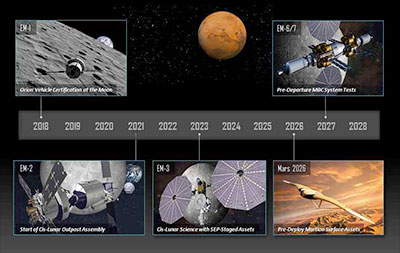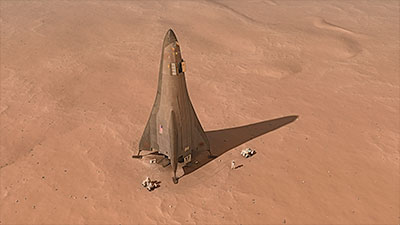 Space News space history and artifacts articles Messages space history discussion forums Sightings worldwide astronaut appearances Resources selected space history documents |
If you have previously registered, but forgotten your password, click here.
The Mars Base Camp concept is built on a strong foundation of today's technologies – making it safe, affordable and achievable: The major components of the architecture will be launched separately. Some are pre-positioned in Mars orbit ahead of time. Others are assembled in cis-lunar space for the journey to Mars. Six astronauts will launch on Orion, which serves as the heart of the Mars Base Camp interplanetary ship.  What is the mission timeline? This notional timeline lays out the major stepping stone missions that will refine and test the technology to make Mars Base Camp possible.  Since the first Viking lander touched down on Mars 40 years ago, humanity has been fascinated with the Red Planet. Lockheed Martin built NASA's first Mars lander and has been a part of every NASA Mars mission since. We're ready to deliver the future, faster. The Mars Base Camp concept builds upon existing deep space technologies in development today and provides a blueprint for NASA's journey to Mars. This plan provides the opportunity for significant scientific discovery, can be evolved to accommodate specific mission objectives, and ensures the safety of our astronauts. Mars is closer than you think. We're ready to accelerate the journey. | ||||||||
| SpaceAholic | Humanity may camp out for a year or so in Mars orbit to get ready for its epic first trek to the Red Planet's surface, reports Space.com. The aerospace company Lockheed Martin recently proposed that NASA work with its international partners and private industry to set up a space station in Mars orbit by 2028. The astronauts working and living aboard this "Mars Base Camp" could help collect information that any future Red Planet explorer would need to know, the project's developers say. | |||||||
| cspg | For an estimated, but most likely to skyrocket through the roof, cost of? | |||||||
| Robert Pearlman | Mars Base Camp is designed to fit within NASA's spending plans for exploration missions over the next 10- to 20-year period, about $50 to $80 billion (between $4 and $9 billion per year), per the FISO briefing. | |||||||
| Robert Pearlman | Lockheed Martin video At no other time in history have we had the technology, the know-how, and the public enthusiasm to get humans to Mars. Orion is NASA's spaceship that will take humans into deep space, but it needs to be a part of a larger system to go to Mars. Lockheed Martin's concept is called Mars Base Camp and it's our idea of how to send humanity's first crewed mission to Mars in about a decade. | |||||||
| perineau | Going a hundred million miles or so to Mars and not landing is like dancing with your sister... | |||||||
| Robert Pearlman | The above video includes, and Lockheed is unveiling in more detail today, its concept for a Mars lander. As valuable as orbiting missions are for science and exploration, we’ll eventually look to leave the base camp and descend to the surface.  | |||||||
| Fra Mauro | Great idea but the funding and long-term commitment are obstacles. | |||||||
| perineau | ...which is why this will never see the light of day. (PITS = Pie In The Sky) Internet buzzes like this will never get us to Mars. Look at how every NASA project from Orion, Starliner and the new booster rocket are running years behind schedule, destined to be cancelled by a disenchanted congress and general public as well. To explore space, we need leadership and not pork-barrel politics. | |||||||
| Robert Pearlman | As unlikely as this particular architecture is to become reality, engineering efforts like this are useful. Elements from the development of this concept will become part of future spacecraft, either by Lockheed itself, or by others who derive inspiration or ideas from seeing it published. | |||||||
| perineau | Point taken, although it illustrates the fact that a manned landing is still several decades away. As French astronaut Jean-Pierre Haigneré said the other day: "We've been hearing for over 30 years now that a martian landing is 30 years away..." | |||||||
